Patient Monitoring Equipment
RPM represents paradigm shift after COVID-19
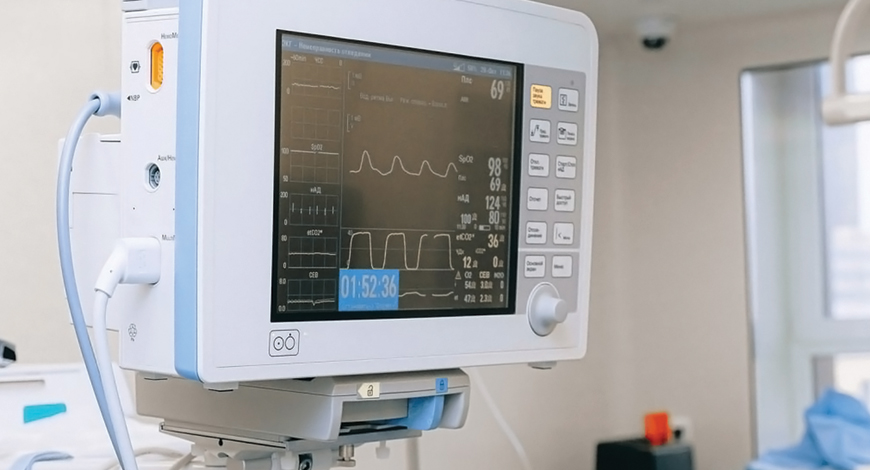
“The success of remote patient monitoring is yet to be seen. Beyond its primary use for monitoring chronic disease patients, and its developing role with COVID-19, the future of healthcare may lie with the expansion of technological advances in virtual care.
COVID-19 outbreak has had a positive impact on the patient-monitoring devices segment. Initially, there was a setback owing to the reduced supply of critical raw materials for production of the devices. However, rising infection rates provided the requisite impetus to the patient-monitoring devices market. As COVID-19 surfaced with fresh variants and the rising infections became a major concern, the demand for patient-monitoring devices and patient-engagement solutions saw a sharp rise among various end-users, including hospitals and surgical facilities.
Manufacturers are increasingly focusing on expanding production to meet the increasing need for respiratory-monitoring devices, multi-parameter-monitoring devices, blood-glucose monitoring devices, cardiac-monitoring devices, temperature-monitoring devices, hemodynamic/pressure-monitoring devices, and fetal/neonatal-monitoring devices.
Unlike telehealth that gained traction only later, remote patient-monitoring (RPM) saw demand as the coronavirus initially started to spread. Although the pandemic will eventually fade away, the need for RPM seems here to stay. The global RPM market is on pace to reach USD 117.1 billion by 2025, compared to USD 23.2 billion in 2020 – more than a five-fold increase in just five years. This is good news for the population, suffering from chronic conditions, as it motivates tech leaders to focus on innovative solutions for continuous and remote disease management, as well as enhanced monitoring of disease damage that could accelerate life-threatening conditions.
Now that RPM has moved to the forefront, the next step is to provide reliable, accurate, and full patient visibility to support patients living with chronic conditions. This means that in parallel to continuous disease management, tech leaders will need to put efforts into disease-burden monitoring, and strive to bring FDA-cleared medical-grade solutions to market that are premised on multiple biomarkers and supported with relevant research and patents for their innovative technologies and processes.
Moving forward, as the population grapples with an array of chronic conditions, the market will expect more companies to join the arena of innovators, tackling single and multiple chronic conditions and providing full data visibility to doctors.
How business leaders, product managers and marketers can contribute to the growth and adoption of RPM. Every business needs a full-funnel marketing strategy. RPM success will likely require a total shift in how patients consume health, providers monitor therapy, and payers cover the bills. This shift was, no doubt, triggered in part by the pandemic, but there is a need to create sustainable, cost-effective patient pathways for the future. The market can benefit from more companies putting their heads into the ring to design these funnels and journeys.
Marketers and product managers will be working together to design these new patient journeys. Together with these journey architects, business leaders could have a set of strategies to maximize healthcare – getting the RPM value proposition right, promoting a digital-ready mindset and culture, engaging the entire healthcare ecosystem, and humanizing the digital experience, while developing remote monitoring products and services. Furthermore, leaders whould be on guard to potentially join collaborations and partnerships to launch innovations faster and more cost-effectively for all.
The industry needs to evaluate the advantages in terms of expenses avoided, productivity gained, and lives enhanced when healthcare developers integrate RPM with a spectrum of tools for complete therapy. While debates rage about whether patient pathways are currently inefficient and ineffective, RPM and its advancements have the potential to reach considerably larger and more significant audiences. Business leaders will play a critical role in growing this market and educating buyers.
The Indian market for patient-monitoring equipment in 2020 is estimated at ₹670.15 crore, and 75,000 units. High-end systems constituted 4.6 percent share in value terms (it was 15.9 percent share in 2019, and 100 units of super premium, had sold in 2019, that seemed to be missing this year) and 1.3 percent in volume terms (it was 7 percent in 2019). The belly of the segment continues to be competitively priced systems, the mid-end, and low-end segment, and the buying in 2020 shifted even more; it has progressively been increasing since 2018. The two segments dominated with a combined share of 85 percent by value and 93 percent by volume. The six brands, Philips, Mindray, Nihon Kohden, GE, BPL, and Schiller continue to lead this segment. This year, the Chinese brands as Contec, Edan, Yonker, and Comen among many others did really well.
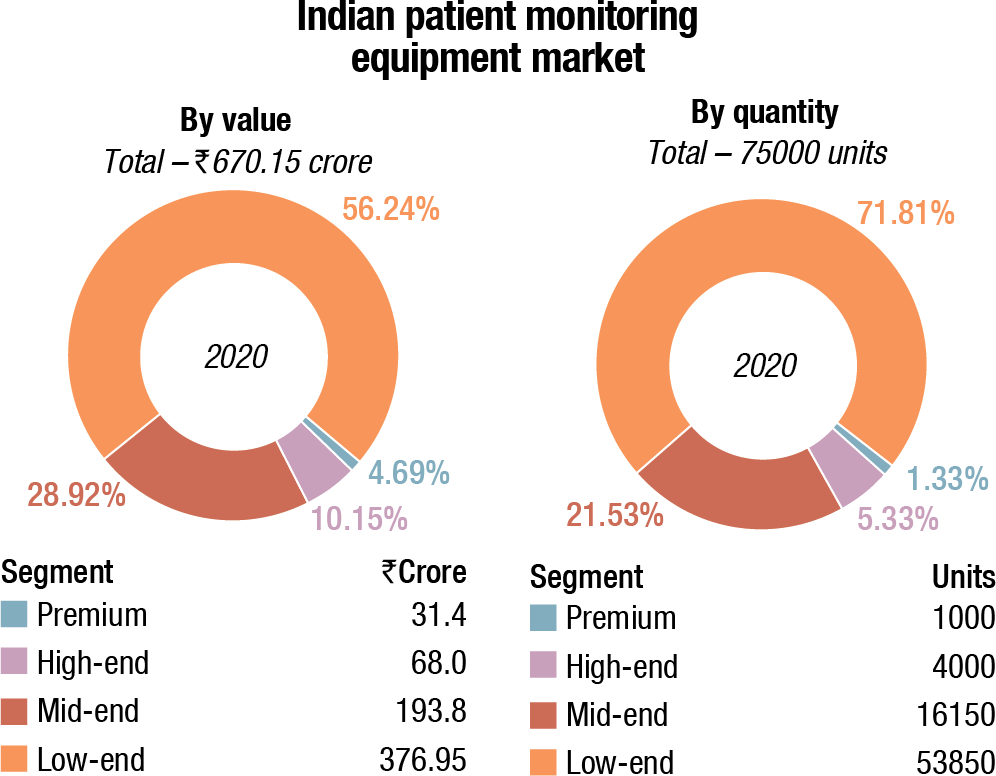
2020 was not a typical year for the Indian patient-monitoring market, as for many other medical equipment and devices. There was an approximate 35 percent increase in demand, with some emphasis on the wireless monitors. This enabled monitoring of patients outside of conventional clinical settings, e.g., in the home. It simplified the accessibility toward healthcare resources, and improved communication between patients and their healthcare providers by simplifying data transmission. Also, the issue of staff shortage was addressed by this.
| Indian patient monitoring equipment market | |
| Leading players – 2020 | |
| Segment | Vendors |
| Tier I | Philips |
| Tier II | Mindray, Skanray, BPL & GE |
| Tier III | Nihon Kohden, Schiller, Contec, Drager & Bionet |
| Others | Edan, Comen, Yonker, and many Chinese brands; Nidek, GMI, Baxter, and EMCO |
| ADI Media Research | |
The market increase was seen in the mid-end, and more so in the low-end monitors, perhaps because the government had minimal procurement this year. This gave an impetus to the Chinese brands. Leading players as Philips had trebled their production in both their plants, Germany and China in 2019.
Patient-monitoring equipment is a central component of every hospital’s workflow. Before the market experienced disruptions caused by the COVID-19 pandemic, the global market for patient-monitoring equipment was valued at approximately USD 3.7 billion in 2020. Due to a sharp increase in demand for monitoring equipment in the diagnosis and treatment of COVID-19, this number has only risen during the pandemic and is expected to grow at a mid-single-digit rate through 2027. Among the fastest-growing markets in this space are cardiac monitoring, remote patient-monitoring (RPM), temperature management, and electroencephalogram (EEG) monitoring.
Beyond the temporary spike in demand, caused by the COVID-19 pandemic, the patient-monitoring equipment market is also expected to grow at a moderate rate for the foreseeable future, driven by an aging demographic, which contributes to further complications requiring monitoring solutions. Improved connectivity in monitors will also be a significant growth driver for this market as hospitals move toward integrated monitoring solutions to improve accessibility and analysis of patient data. Finally, technological advancements in various patient-monitoring equipment markets will also drive growth as in-demand new features command higher selling prices.
Patient monitoring industry in India
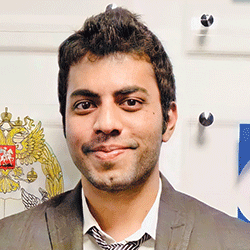 Shreyas HM
Shreyas HM
Project Lead – Marketing and Sales,
Skanray Technologies Limited
Patient monitoring devices continuously monitor the patient’s vital parameters and collect medical data from patients. The Indian patient monitoring market is segmented by the type of device, target area, and end-user.
Market trends
Indian health systems are turning to remote patient monitoring (RPM) technology to ensure improved outcomes and reduced costs. It is a healthcare delivery technology to monitor patients outside of a traditional clinical setting. Such patient care extends the reach of physicians, enabling a constant relationship between patients and caregivers.
There has been a significant government push to enable healthcare for the underserved, making technology adoption imperative. With the release of the telemedicine guidelines by the Ministry of Health & Family Welfare (MoHFW), the regulatory environment has become clearer.
The guidelines prepared in collaboration with the NITI Aayog allow consultations via multifarious communication channels such as text, audio and video, and crucially permit registered medical practitioners to prescribe medicines. Along with structured regulatory guidelines and technological advancement in terms of reconfiguration and statistical analysis of a vast-vivid database with the Government of India, India’s patient monitoring market is predicted to have its market opportunities increased by up to 20 percent by 2030.
Current market opportunity
The COVID-19 pandemic has led to a spike in the demand for patient monitoring devices that can help monitor, diagnose, and treat patients with chronic respiratory diseases and diabetes. According to the International Diabetes Federation, adults with diabetes were estimated to be 77,005,600 in India in 2020. According to World Ageing 2019 report, in India, the population aged 65 years or over was 87.149 million (6.4%) in 2019, which is projected to reach 128.877 million (8.6%) by 2030.
As the number of elderly who are more prone to diseases is expected to grow, the increase in market demand for patient monitors is predicted. Owing to the rapid evolution of the market in using medical technology, the Indian patient monitoring market is projected to register a CAGR of 6.4 percent during 2021–2025.
By product, the cardiac monitoring systems segment held the largest revenue share of more than 19.5 percent in 2020. It is estimated to garner USD 10.26 billion by 2027, registering a CAGR of 4.8 percent from 2020 to 2027. According to the WHO, cardiovascular diseases (CVDs) are the major causes of death across the globe, and approximately 30 million people suffer a stroke and heart attack annually. The rising incidence of cardiac disease is increasing the demand for cardiac-monitoring system devices; hence, major market players are trying to meet the needs by launching new products.
As RPM devices can be used remotely to monitor critical parameters of patients, the segment is rapidly gaining popularity among patients with chronic diseases, such as diabetes, hypertension, and chronic respiratory diseases. Thus, it is expected to be the fastest growing segment, registering a CAGR of 6.3 percent from 2020 to 2027. The other segments for the market include hemodynamic monitoring, neuromonitoring, fetal and neonatal monitoring, respiratory monitoring, multi-parameter monitoring, remote patient-monitoring, weight monitoring, and temperature-monitoring devices.
By end-use, the hospital segment dominated the market and accounted for the largest revenue share of more than 51.3 percent in 2020. The large share of the market is anticipated to the rising emphasis on effective and early disease diagnosis in hospitals, and the growing procedural volume in hospital settings. The other segments for the market include hospitals, ambulatory surgical centers, home care settings, and others. The home care segment is anticipated to witness rapid growth over the next seven years. There is an increasing trend toward portability and delivery of care at home or at the bedside, which is accelerating the development of next-generation therapeutic, diagnostic, display, and monitoring-equipment design, which is more versatile, precise, and compact.
North America dominated the patient-monitoring devices market and accounted for the largest revenue share of more than 42.7 percent in 2020. Increasing incidence of chronic diseases, coupled with the presence of advanced technology, demand for wireless and portable systems, aimed at cutting out-of-pocket expenditure are some of the factors attributed to the growth of the market in the region.
Also, major market players, such as Edward Lifesciences, GE Healthcare, Masimo Corporation, and Natus Medical are investing in R&D for more advanced patient-monitoring devices facilities, which, in turn, will boost the market in the coming years.
In Asia-Pacific, the market is anticipated to witness lucrative growth, owing to the adoption of a sedentary lifestyle in the region, such as poor diet, physical inactivity, and high consumption of sugar that leads to many chronic conditions, such as obesity, diabetes, and others. India and China have the largest diabetic population and it is expected to increase over the forecast period. This leads to an increase in awareness regarding diabetes-preventive care, which, in turn, is anticipated to augment the market growth.
Major players operating in the market include Medtronic, Inc., Biotronik, F. Hoffmann-La Roche Ltd., GE Healthcare Ltd., Masimo Corporation, Nihon Kohden Corporation, Johnson and Johnson, Omron Healthcare Co. Ltd., Abbott Laboratories, and Koninklijke Philips N.V.
Leading brands are going in for acquisitions and simultaneously launching new products to strengthen their position in the market.
In January 2021, Boston Scientific Corporation announced to acquire Preventice Solutions, Inc., a privately held company offering remote and wearable cardiac monitors for adults and pediatric patients. The acquisition will establish a strong footprint of Boston Scientific Corporation in the implantable cardiac-monitor market.
In December 2020, Konica Minolta, Inc. launched VS1, a patient-monitoring system in Japan for COVID-19 hospitalized patients with mild to moderate conditions in the isolation zones.
Trends – O2 patient monitors
 N Manogaran
N Manogaran
Vice President – Sales,
BPL Medical Technologies Pvt. Ltd.
Demand for patient monitors has increased during both pandemic and post-pandemic periods. Monitoring patients’ vitals has become significant. The requirement for additional parameters, like IBP and ETCO2, is also on the rise. As a part, respiratory monitoring SPO2 and ETCO2 parameters are important, and hence ETCO2 module requirements are higher. Users started looking for established brands for better reliability and service support. As always, preconfigured monitors continue to have a higher market share. Wireless connectivity and remote central monitoring station are gaining importance. OR upgrades and expansion set increased demand for AGM monitoring solutions and high-end monitors. Many hospitals started focusing on pediatric and neonatal care and hence monitors for such applications find increased demand. There were many tenders opened in the recent past exclusively for pediatric and neonatal monitors. Overall, the patient monitor market will be posting good growth.
In November 2020, Masimo Corporation announced the acquisition of advanced hemodynamic-monitoring devices manufacturer, Lidco, for an estimated amount of USD 40.1 million. This device is primarily designed for critical intensive care and high-risk surgical patients across the US and the UK. It is also available across continental Europe, Japan, and China.
In July 2020, Medtronic received 510(k) clearances from the FDA and CE for its LINQ II insertable cardiac monitor (ICM). LINQ II is a small wireless ICM for patients with abnormal heart rhythms, and for those who require long-term monitoring. It enables remote patient-monitoring and data transfer through the MyCareLink Heart mobile app or MyCareLink Relay home communicator by using BlueSync technology.
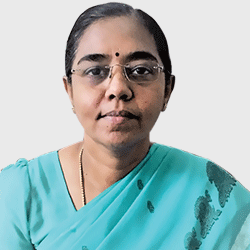 J. Indhumathi
J. Indhumathi
Superintending Engineer, Biomedical Engineering,
Christian Medical College, Vellore
The pandemic since March 2020 has led to the increase in the demand for remote monitoring systems. Continuous glucose monitoring, temperature monitoring, blood-pressure monitoring, and pulse oximetry are a few applications of wearable patient-monitoring devices, biosensors, and smart implants, and the vital signs so monitored can be transmitted over mobile wireless networks. The market growth will be attributed to the technological advancements, growing investments, grants, and growing incidences of target diseases, growing number of approvals for patient monitoring, large population, chronic diseases, demand for advanced technologies, rising healthcare spending, etc. Increasing pressure to reduce healthcare costs, price regulations, competitive pricing, bidding and tender mechanics, coverage and payment policies, comparative effectiveness of therapies, technology assessments, and managed-care arrangement and taxes are expected to increase operational costs, which will indirectly affect the cash flow of medical devices companies across major healthcare markets worldwide.
As the healthcare ecosystem evolves over the years, one of the major trends has been the acceptance and evolution of patient-monitoring systems to augment patient care. Some of the trends expected to drive demand for patient-monitoring equipment are:
Improved connectivity. Monitors being released today are typically equipped with connectivity features, such as the EarlyVue monitor from Philips and the Carescape vital signs monitors from GE. Monitoring solutions in other markets (such as remote cardiac implantable devices, electromyogram (EMG) monitors, fetal and neonatal monitors, pulse-oximetry monitors, and blood-pressure monitors) are also incorporating this feature. Some personal-use blood-pressure monitors are also offering smartphone connectivity capabilities for users to obtain readings, store results, analyze trends, and share data with their healthcare providers. The better connectivity and accessibility of data has spurred heavy investment in adjacent markets as well, such as the data analytics and artificial intelligence space. In 2020, Medtronic announced a series of acquisitions in the data analytics and AI space, including the British data analytics company, Digital Surgery, French spinal implant manufacturer, Medicrea, and US-based Ai Biomed Corp. This series of acquisitions is indicative of a greater industry movement toward shared data streams and advanced data analytics, with demand in each market being mutually reinforced by the other.
Technological advancements. There is a great deal of innovation in the patient-monitoring space. In terms of vital-signs monitors, these advancements include data streaming, touch screens, and compatibility with magnetic resonance imaging (MRI) machines. With regard to remote monitoring solutions, technologies are becoming more efficient, effective, and safe to use. Improvements and the increased availability of wireless data transmission networks will facilitate the development of platforms for telehealth and remote monitoring. In various other markets, like fetal/neonatal monitoring and cardiac output monitoring, there is an increased focus on the use of less invasive and non-invasive monitoring techniques. Such products include the Argos monitor from Retia Medical, with its ease of use and interoperability with existing vital-signs monitors. As various patient monitors become more advanced and carry more features, they will naturally command a higher average selling price and greater clinical demand.
With respect to consumables, there is a shift in demand toward disposable units as a proactive means of reducing cross-contamination risk and reducing liability concerns. Each of the aforementioned trends is in line with the general drive to improve patient outcomes through reduced complication and mortality rates, thereby promoting long-term cost savings. This will, in turn, help to improve the quality of care, while also alleviating pressure associated with budgetary constraints across the care continuum.
Non-invasive technology. New non-invasive CCO technology can be used either with IBP or NIBP, enabling continuous, accurate, and patient-specific hemodynamic-trend monitoring along the entire clinical pathway. Managing and monitoring hemodynamic trends can help improve the quality of care in perioperative, emergency, high-dependency, and intensive care settings. New non-invasive hemodynamic monitoring can also be continuously used and calibrated when patients are undergoing higher-risk procedures, and the hemodynamic monitor of choice is more invasive (e.g., bolus thermodilution). Moreover, when the risks surrounding these patients decrease, hemodynamic monitoring can be continued with new non-invasive CCO. New non-invasive hemodynamic monitoring is available now in patient monitors, without requiring extra procedures, equipment, or additional knowledge for implementation.
Wireless sensor technology/wearable sensors. Increases the comfort of patients and enabling staff to more easily assist and move them. Federal communication commission announced allocation of a section of the broadcast spectrum for medical body area network (MBAN) in hospitals. MBANs transmit a stream of continuous real-time data about patient’s condition.
Real-time and remote patient-monitoring. Telemedicine is becoming more of a reality these days. It enables healthcare professionals to serve remote and less-populated areas. With our aging population, the need for monitoring patients, wherever they live and work, is increasing, which also reduces expensive hospital stays. There is a growing trend of shifting treatment from hospitals to homes in order to reduce hospital bills.
Use of big data. Big data is shaking the healthcare industry. It is helping the industry progress in all fronts, including precision medicine, predictive analytics, fraud detections, and clinical trials. It has affected all healthcare areas from oncology, neurology, genomics, to cardiology. Big data allows healthcare professionals to analyze sizeable medical data sets across a vast population to explore research and treatment opportunities. Big data can help to identify patients who are susceptible to specific conditions and prescribe specific preventive measures to head them off.
IoT. The increasing use of IoT (Internet of Things) technology for analyzing continuous-glucose monitoring, blood-pressure observation, temperature recording, and pulse oximetry is helping to improve the capabilities of remote patient-monitoring devices. It will allow patients and providers to work together for deeper engagements, open communication, and chronic-disease management. By accumulating, transmitting, processing, and storing such information, the devices enable doctors/practitioners to uncover patterns and discover potential health risks associated with a patient. As a result of rising technological advancements, these technologies are proving to be more efficient and accurate, which in turn has made it easier for doctors to diagnose patients accurately and help them in recovering from their past traumas. Growing penetration of 5G technology could enhance the performance of these devices, thereby giving the global market for patient-monitoring devices more growth prospects.
AI-based predictive analysis. Analysis of the sizeable data gathered with monitoring shall be a means of equipping healthcare professionals with intelligent assistance for actionable insight. For example, a predictive model, using chronic disease patient’s continuous measured parameter, can provide a prediction of patient’s disease progression and assist in precision medication. Nowadays, with the advancements and adoption of AI and Machine Learning with real-time data, the predictive analysis of the patient condition and patient risk scoring makes patient care better and focused.
while the six brands continued to be in demand, it is the chinese brands in india that took advantage of the increased demand.
As the global industry continues to respond to the COVID-19 crisis, all sectors of healthcare system are witnessing extraordinary and innovative ways to deal with this unique challenge. Remote patient-monitoring is a critical tool in the healthcare arsenal. It will serve as a complement to telehealth and other tools, giving healthcare professionals across the country access to all the information they need to make the best-informed decisions to treat their patients.
Patient-monitoring will play a critical role in enabling the change in this setting. In order to be competitive in this shifting market, patient-monitoring providers will need to change their business models and product roadmaps. Future monitoring should be more adaptable and responsive to the demands of value-based healthcare. The increased use of monitoring in all areas of the hospital will be driven by the need to improve the quality of treatment and minimize undesirable events. Healthcare teams will be able to respond more quickly to any abrupt or gradual deterioration if patients’ conditions are continuously monitored while in the hospital.
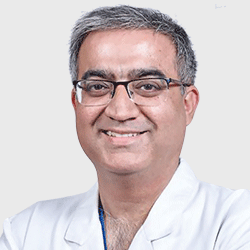 Dr Sandeep Dewan
Dr Sandeep Dewan
Director and Head of Department,
Critical Care Medicine,
Fortis Memorial Research Institute, Gurgaon
In the last two years, since the world was hit by COVID pandemic, the need for remote patient monitoring has become apparent. The monitors should have these kinds of features so that the ICU monitoring can be made easier and more affordable.
Role of patient-monitoring equipment in COVID-19 era
In COVID ICUs, remote patient monitoring allows doctors to maintain a close eye on their chronically sick patients in an effective manner. Additionally, treating high-risk patients remotely, using patient-monitoring equipment, helps to protect the health of patients, doctors, and staff.
Access to patient’s real-time data
With the help of remote patient-monitoring tools, the real-time data can be accessed by the doctor anytime and anywhere on tabs, monitors, smart phones, laptops, which makes it easier to identify the alerts of the patient in a critical condition.
Impact of color coding of real-time data
The color-coded display of real-time data on screens has a significant influence on monitoring and recognizing warnings. A patient who requires immediate care can be color coded as red, and hence others can be coded likewise on the screen.
Technological advancements in terms of accuracy and patient comfort, as well as connectivity and data analysis, will also be major growth drivers in this market for the foreseeable future. While the COVID-19 pandemic has presented challenges for some markets in the patient-monitoring space, others have grown. In either case, the market is set to stabilize and continue its trend of modest growth in coming years.











